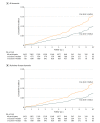Assessment of Plasma Total Tau Level as a Predictive Biomarker for Dementia and Related Endophenotypes
- PMID: 30830207
- PMCID: PMC6515589
- DOI: 10.1001/jamaneurol.2018.4666
Assessment of Plasma Total Tau Level as a Predictive Biomarker for Dementia and Related Endophenotypes
Abstract
Importance: Blood-based biomarkers have the potential to improve the identification of persons with the greatest dementia risk for inclusion in dementia prevention trials through low-cost and minimally invasive screening.
Objective: To investigate the use of plasma total tau as a blood biomarker for dementia and related endophenotypes.
Design, setting, and participants: This prospective cohort study used data from the US community-based Framingham Heart Study with replication in the Memento study, a multicenter cohort of persons with mild cognitive impairment or subjective cognitive complaints recruited from memory clinics across France. Total tau levels were measured from stored plasma samples in Framingham Heart Study participants during 2004 to 2011. Dementia follow-up occurred across a median of 6 years (interquartile range, 5-8 years) for persons 65 years and older who were dementia free at baseline. Plasma and/or cerebrospinal fluid samples were obtained from Memento study participants from April 19, 2011, to June 22, 2016. Dementia follow-up took place over a median of 4 years (interquartile range, 3-5 years). Data analysis was performed from January to November 2018.
Exposures: Plasma total tau level measured using single-molecule array technology.
Main outcomes and measures: Incidence of dementia of any cause (all dementia) and dementia due to clinical Alzheimer disease (AD dementia).
Results: Among the 1453 participants in the Framingham dementia study sample, the mean (SD) age was 75 (7) years; 792 (54.5%) were female. Among the 367 individuals in the replication cohort, the mean (SD) age was 69 (9) years; 217 (59.1%) were female. Of 134 cases of incident all dementia in the Framingham sample, 105 were AD dementia. After adjustment for age and sex, each SD unit increase in the log of plasma total tau level was associated with a 35% increase in AD dementia risk (hazard ratio [HR], 1.35; 95% CI, 1.10-1.67). The addition of plasma total tau to a model including age and sex improved the stratification of participants for risk of AD dementia (net reclassification improvement, 0.382; 95% CI, 0.030-0.716). Higher plasma total tau level was associated with poorer cognition across 7 cognitive tasks (P < .05) and smaller hippocampi (hippocampal volume: β [SE] = 0.002 [0.001]; P = .003) as well as neurofibrillary tangles (β [SE] = 0.95 [0.45]; P = .04) and microinfarcts (odds ratio, 3.04; 95% CI, 1.26-7.37) at autopsy. In the replication cohort, plasma total tau level weakly correlated with cerebrospinal fluid total tau level (Spearman correlation coefficient, 0.16; P = .07), but plasma total tau was at least as strongly associated with incident AD dementia as cerebrospinal fluid total tau (log plasma total tau: HR, 2.33; 95% CI, 1.00-5.48; log cerebrospinal fluid total tau: HR, 2.14; 95% CI, 1.33-3.44) after adjustment for age and sex.
Conclusions and relevance: The findings suggest that plasma total tau levels may improve the prediction of future dementia, are associated with dementia endophenotypes, and may be used as a biomarker for risk stratification in dementia prevention trials.
Conflict of interest statement
Figures


Similar articles
-
Association Between Longitudinal Plasma Neurofilament Light and Neurodegeneration in Patients With Alzheimer Disease.JAMA Neurol. 2019 Jul 1;76(7):791-799. doi: 10.1001/jamaneurol.2019.0765. JAMA Neurol. 2019. PMID: 31009028 Free PMC article.
-
Longitudinal Associations of Blood Phosphorylated Tau181 and Neurofilament Light Chain With Neurodegeneration in Alzheimer Disease.JAMA Neurol. 2021 Apr 1;78(4):396-406. doi: 10.1001/jamaneurol.2020.4986. JAMA Neurol. 2021. PMID: 33427873 Free PMC article.
-
Plasma tau, neurofilament light chain and amyloid-β levels and risk of dementia; a population-based cohort study.Brain. 2020 Apr 1;143(4):1220-1232. doi: 10.1093/brain/awaa054. Brain. 2020. PMID: 32206776 Free PMC article.
-
Amyloid beta protein and tau in cerebrospinal fluid and plasma as biomarkers for dementia: a review of recent literature.Curr Clin Pharmacol. 2008 May;3(2):123-31. doi: 10.2174/157488408784293723. Curr Clin Pharmacol. 2008. PMID: 18700307 Review.
-
Risk estimations, risk factors, and genetic variants associated with Alzheimer's disease in selected publications from the Framingham Heart Study.J Alzheimers Dis. 2013;33 Suppl 1(0 1):S439-45. doi: 10.3233/JAD-2012-129040. J Alzheimers Dis. 2013. PMID: 22796871 Free PMC article. Review.
Cited by
-
Alzheimer's disease and inflammatory biomarkers positively correlate in plasma in the UK-ADRC cohort.Alzheimers Dement. 2024 Feb;20(2):1374-1386. doi: 10.1002/alz.13485. Epub 2023 Nov 27. Alzheimers Dement. 2024. PMID: 38011580 Free PMC article.
-
Associations of the APOE ε2 and ε4 alleles and polygenic profiles comprising APOE-TOMM40-APOC1 variants with Alzheimer's disease biomarkers.Aging (Albany NY). 2022 Nov 17;14(24):9782-9804. doi: 10.18632/aging.204384. Epub 2022 Nov 17. Aging (Albany NY). 2022. PMID: 36399096 Free PMC article.
-
A Prospective Study on Neural Biomarkers in Patients with Long-COVID Symptoms.J Pers Med. 2024 Mar 16;14(3):313. doi: 10.3390/jpm14030313. J Pers Med. 2024. PMID: 38541055 Free PMC article.
-
Revolutionizing the Early Detection of Alzheimer's Disease through Non-Invasive Biomarkers: The Role of Artificial Intelligence and Deep Learning.Sensors (Basel). 2023 Apr 22;23(9):4184. doi: 10.3390/s23094184. Sensors (Basel). 2023. PMID: 37177386 Free PMC article. Review.
-
In the blood: biomarkers for amyloid pathology and neurodegeneration in Alzheimer's disease.Brain Commun. 2020 Jul 2;2(1):fcaa054. doi: 10.1093/braincomms/fcaa054. eCollection 2020. Brain Commun. 2020. PMID: 32954304 Free PMC article.
References
Publication types
MeSH terms
Substances
Grants and funding
LinkOut - more resources
Full Text Sources
Other Literature Sources
Medical
Miscellaneous

